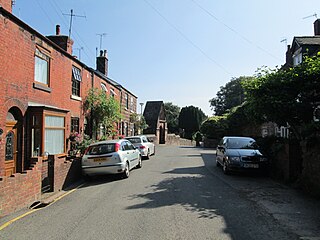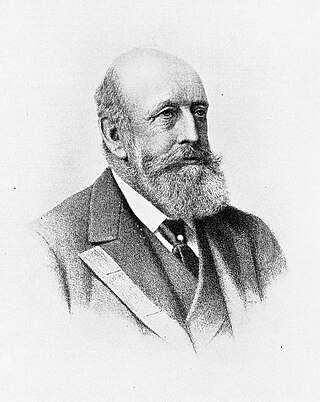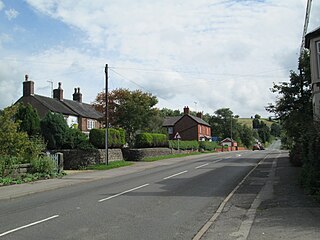
Leek is a market town and civil parish in Staffordshire, England, on the River Churnet 10 miles (16 km) north east of Stoke-on-Trent. It is an ancient borough and was granted its royal charter in 1214.

Endon is a village within the Staffordshire Moorlands district of Staffordshire, England. It is 4 miles (6.4 km) southwest of Leek and 6 miles (9.7 km) north-northeast of Stoke-on-Trent. Endon was formerly a township in civil parish of Leek.

Caldon Canal is a branch of the Trent and Mersey Canal which opened in 1779. It runs 18 miles (29 km) from Etruria, Stoke-on-Trent, to Froghall, Staffordshire. The canal has 17 locks and the 76-yard (69 m) Froghall Tunnel.

The Churnet Valley Railway is a preserved standard gauge heritage railway in the Staffordshire Moorlands of Staffordshire, England. It operates on part of the former Churnet Valley Line which was opened by the North Staffordshire Railway. The railway is roughly 10.5 miles (16.9 km) long from Kingsley and Froghall to Ipstones. The land from Leek Brook Junction to Ipstones was opened by Moorland & City Railways (MCR) in 2010 after they took a lease out from Network Rail. This has subsequently been purchased by the Churnet Valley Railway. The main stations along the line are Kingsley and Froghall, Consall, Cheddleton and Leek Brook. Work has begun to extend the line to the town of Leek which will act as the northern terminus of the line. The line between Leek and Waterhouses has also been reopened as part of the heritage railway as far as Ipstones.

Staffordshire Moorlands is a constituency represented in the House of Commons of the UK Parliament since 2010 by Karen Bradley, a Conservative who served as Secretary of State for Culture, Media and Sport between 2016 and 2018, before she became Secretary of State for Northern Ireland from 2018 to 2019. As with all constituencies, the constituency elects one Member of Parliament (MP) by the first past the post system of election at least every five years. This seat saw a swing to the Conservatives at the elections from 2010–2019.

Cheddleton is an ancient parish and village in the Staffordshire Moorlands, near to the town of Leek, England.

William Bagot, 1st Baron Bagot, known as Sir William Bagot, 6th Baronet, from 1768 to 1780, was a British politician who sat in the House of Commons from 1754 to 1780. He was then raised to the peerage as Baron Bagot.
This is a list of the sheriffs and high sheriffs of Staffordshire.

Brocton Hall is a building of historical significance and is listed on the English Heritage Register. It was built in 1760 by William Chetwynd and remained in the Chetwynd family until 1923 when it was sold to the Golf Club. Today the building is still used as a clubhouse and is also a venue for weddings.
The Bellot Baronetcy, of Moreton in the County of Chester, was a title in the Baronetage of England. It was created on 30 June 1663 for John Bellot of Great Moreton Hall, near Astbury, Cheshire, who was High Sheriff of Staffordshire in 1661. He came from an ancient Cheshire family, and was the eldest son of John Moreton and Ursula Bentley. The second Baronet was several times Member of Parliament for Newcastle-under-Lyme. The baronetcy became extinct on the death of the fourth Baronet in 1714. The Moreton estate was sold on his death.

Madeley Old Manor, was a medieval fortified manor house in the parish of Madeley, Staffordshire. It is now a ruin, with only fragments of its walls remaining. The remnants have Grade II listed building status and the site is a Scheduled Ancient Monument. The Tudor manor house is illustrated by Michael Burghers as it appeared in 1686 in Plot's History of Staffordshire, together with the formal gardens and a later east frontage. It is situated a short distance to the south of Heighley Castle, a mediaeval seat of the Audley family.
Thomas Trentham (1538–1587) was an English politician.

North Rode Manor is a country house standing to the north of the village of North Rode, Cheshire, England. The house was built between 1838 and 1840 for John Smith Daintry, a banker and silk manufacturer from Macclesfield, on the site of an earlier house that had been destroyed by fire. Alterations have been carried out since it was originally built. The house is constructed in stuccoed brick with ashlar dressings and slate roofs. It is in two storeys. The entrance front has five bays, the two on the left protruding forwards. The entrance porch dates from the 19th-century and is supported by paired Tuscan columns. To the right of this is a canted bay window. On the right side of the house is another canted bay window, and on the left side is a tower with a pyramidal roof. The house is recorded in the National Heritage List for England as a designated Grade II listed building. The authors of the Buildings of England series describe it a "sprawling white house in Regency Gothic".
Lieutenant-Colonel Walter Sneyd, of Keele Hall was an English politician who served in the Parliament of Great Britain and as High Sheriff of Staffordshire.

Sir Thomas Wardle was a British businessman, known for his innovations in silk dyeing and printing on silk. He was married to celebrated fabric artist Elizabeth Wardle. He collaborated with the designer William Morris, who visited his dyeworks in Leek, Staffordshire to learn how to use natural dyes. He was knighted by Queen Victoria for his services to the silk industry.

Rushton is a civil parish in Staffordshire, England. The village within the civil parish, usually known as Rushton Spencer, is about 4 miles (6.4 km) north of Leek and 7 miles (11 km) south of Macclesfield, on the A523 road which runs between these towns.

Longsdon is a village and civil parish in the Staffordshire Moorlands district of Staffordshire, England, about 1.5 miles (2.4 km) southwest of Leek, on the A53 road.

Ashcombe Park is a country house and estate near Cheddleton, in Staffordshire, England.
John Sneyd (1734–1809) was an English landowner, at Bishton Hall near Colwich, and Belmont Hall near Ipstones, Staffordshire, and High Sheriff of Staffordshire in 1763. He was a prominent citizen of Lichfield. He was known also as a botanist, agriculturist and tree-planter.
















